Did you know a well-fed pothos plant can grow up to 10 feet long indoors? Pothos, also known as devil’s ivy or epipremnum, is a favorite houseplant that’s easy to care for. It can survive without fertilizer, but the right food boosts its growth and makes its leaves more vibrant. This article will cover why fertilizing pothos is important, the best fertilizers, and how to apply them right to help your plant grow its best.
Key Takeaways
- Pothos plants benefit from monthly fertilization during the active growing season of spring and summer.
- Granular fertilizers with an NPK ratio around 3-1-2 or a balanced 2-2-2 can be beneficial for pothos.
- Signs that a pothos needs fertilizer include slow growth, stunted leaves, and pale or yellowing foliage.
- Liquid fertilizers, such as Espoma Organic Indoor Houseplant Food, can be a suitable choice for pothos plants.
- Overfeeding can be harmful, so it’s essential to follow the recommended application frequency and dosage.
The Importance of Fertilizing Pothos
Pothos plants, also known as Devil’s Ivy, are known for their toughness and ability to do well indoors. But, even these tough plants need regular pothos feeding to keep their leaves bright and grow well. It’s key to know the right pothos nutrient requirements for your Golden Pothos’s health and growth.
Feeding your pothos regularly has many benefits. It adds back important nutrients like nitrogen, phosphorus, and potassium that the soil loses over time. This keeps your pothos healthy and helps it grow bigger and look better.
Fertilizing pothos also boosts its health and strength. Nutrients like phosphorus and potassium are vital for strong roots, fighting diseases, and handling stress. Giving your pothos the right pothos nutrient requirements stops nutrient shortages and keeps it doing well at home or in the office.
Proper fertilization can be the difference between a vibrant, healthy pothos and one that struggles to survive.
Fertilizing pothos also makes them look better. Well-fed pothos plants have leaves that are richer and more colorful. This makes them a great addition to any room, especially if you’re growing them for their looks or as part of a plant collection.
Knowing how important pothos feeding is and giving your plant the right pothos nutrient requirements helps your Golden Pothos stay healthy and beautiful. This way, it can keep adding its lush greenery to your space.
Pothos Fertilizer Needs
Pothos plants need specific nutrients to grow well. It’s important to know these needs to pick the right fertilizer. They do best with a balanced fertilizer that has nitrogen, phosphorus, and potassium (NPK).
Understanding Nutrient Requirements
Nitrogen helps with leaf growth. Phosphorus is good for roots and flowers. Potassium makes the plant strong and fights diseases. When picking a fertilizer, look at the NPK ratio. Choose one made for pothos to get the right nutrients.
- Pothos plants are fairly fast-growing plants.
- Pothos plants need three main nutrients: nitrogen, phosphorus, and potassium. They also need calcium, magnesium, and sulfur, plus boron, copper, iron, manganese, and zinc.
- Signs of nutrient lack in Pothos include yellow leaves, brown edges, fading patterns, long vines, droopy leaves, slow growth, and weak roots.
A balanced fertilizer with an equal NPK ratio (like 10/10/10) is best for Pothos. Adjust how much you use and how often. Knowing what nutrients pothos needs helps your plant grow strong.
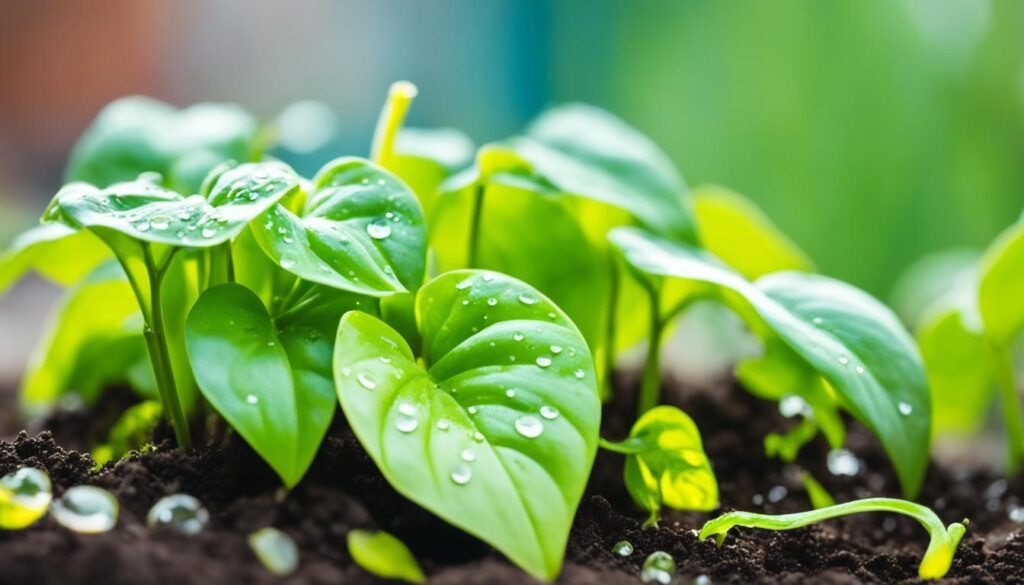
Choosing the Right Pothos Fertilizer
Choosing the right fertilizer is key to keeping your pothos plant healthy. Pothos plants quickly use up the nutrients in their soil. So, you need to feed them regularly to keep their leaves looking green and full.
There are two main types of fertilizers for pothos: liquid and granular. Each has its own benefits.
Liquid vs. Granular Fertilizers
Liquid fertilizers dissolve in water, letting your plant soak up the nutrients easily. They let you control how much fertilizer you give your plant. You can add them with your watering, making sure your pothos gets what it needs.
Granular fertilizers release nutrients slowly over time. They don’t need to be applied as often but can be tricky. Their release can be unpredictable, which might lead to too much or too little fertilizer.
When picking a fertilizer, look for one with a balanced NPK ratio. This means 3-1-2 or 2-2-2. Pothos Plant Food on Amazon has this balance, helping your plant grow well.
“Liquid fertilizer is preferred due to its precise dosage control for plant absorption.”
Think about what you prefer and what your plant needs when choosing a fertilizer. Both liquid and granular fertilizers work well. Your choice might depend on how you garden and how much control you want over feeding your plant.
Fertilizing Schedule for Pothos
Fertilizing your pothos plant is all about finding the right balance. Pothos don’t need a lot of food, so they don’t need to be fed often. In spring and summer, when they grow the most, fertilize your pothos about once a month. This keeps the soil full of nutrients and helps the plant grow strong.
But, don’t overdo it with the fertilizer. Overfeeding can harm your pothos. When fall and winter come, stop fertilizing because the plant is dormant. Start again in late winter or early spring when it starts growing again.
The best time to feed your pothos is every four to six weeks in spring and summer with a balanced fertilizer. This keeps the plant’s leaves green and healthy. Choose a balanced N-P-K ratio of around 20-20-20 for the best nutrition.
“Proper fertilization is key to maintaining a healthy and vibrant pothos plant. Stick to a consistent schedule during the active growing season for best results.”
By sticking to this pothos fertilization schedule, your plant gets the right amount of food. This way, you avoid the dangers of too much fertilizer. Always be careful when feeding your pothos.
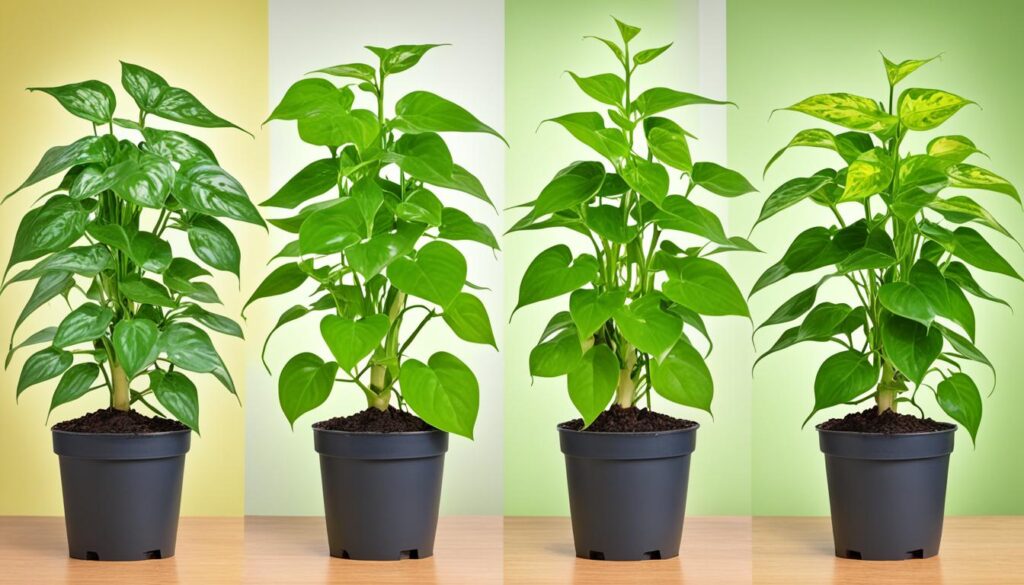
Signs Your Pothos Needs Fertilizer
Pothos plants are known for being tough and adaptable. Yet, they still need regular feeding to stay healthy. Watching your pothos closely can show you when it needs more nutrients.
Recognizing Nutrient Deficiencies
If your pothos grows slowly or stops making new leaves, it might need fertilizer. Yellow leaves can also mean it’s lacking nutrients. Stunted growth, wilting, and leaves that look pale or off-color suggest it’s time to feed it.
By keeping an eye on your pothos, you can spot these signs early. This lets you give it the balanced fertilizer it needs. This keeps it healthy and looking great.
“Fertilizing your pothos regularly can help maintain its lush, trailing foliage and encourage robust growth throughout the year.”
Feeding your pothos during the growing season helps it stay healthy. With the right care, including water and light, your pothos will flourish. Catching nutrient issues early keeps your plant looking its best.
Pothos Fertilizer
Choosing the right pothos plant food is key to caring for your pothos plant. Pothos, or epipremnum, do best with a balanced fertilizer. This fertilizer should match their specific needs.
Opt for an epipremnum fertilizer with an NPK ratio of 3-1-2 or 2-2-2. This mix of nitrogen, phosphorus, and potassium helps pothos grow strong and green. A liquid fertilizer like Espoma Organic Indoor Houseplant Food works well. It’s easy to mix and gives nutrients with each watering.
For another option, consider granular slow-release fertilizers made for flowering plants. These have more phosphorus to help with blooming and plant health.
“Proper fertilization is crucial for maintaining the lush, trailing growth and vibrant foliage that make pothos plants so popular.”
It’s important to balance pothos nutrient requirements. Too much fertilizer can harm your plant. Always follow the instructions and adjust as needed based on your plant’s growth and environment.

With the right fertilizer, your pothos will grow well, stay green, and thrive for many years.
Fertilizing Techniques for Pothos
Proper fertilization is key to keeping a pothos plant healthy. The way you apply fertilizer affects how well the plant absorbs nutrients. Let’s look at the best ways to fertilize your pothos.
For liquid fertilizers, use them once a month when the plant is growing. Make sure to dilute the solution to half-strength to prevent over-feeding. After, water the plant well to spread the nutrients in the soil. This helps the roots take in the nutrients they need.
Slow-release granular fertilizers should be applied in spring and summer’s start. Use the amount suggested on the label for the right nutrients. But, avoid putting granules on the leaves to prevent damage.
Keeping a steady fertilization schedule is crucial for a healthy pothos. By knowing the best pothos fertilization methods, you can give your plant what it needs for growth and color.
“Proper fertilization is the foundation for a lush and robust pothos plant.”
It’s important to find a fertilization routine that fits your pothos and its environment. Try different methods and adjust as needed to make sure your plant gets the right nutrients.
By using these proper pothos feeding techniques, your pothos will get the nutrients it needs to flourish. Happy fertilizing!
Over-Fertilization Risks
Too much fertilizer can harm your pothos. Too many nutrients in the soil can cause yellow leaves, slow growth, and root damage. It’s important to know the signs of over-fertilized pothos and fix it quickly.
Identifying and Addressing Over-Fertilization
Yellowing or wilting leaves are clear signs of over-fertilized pothos. Too many nutrients change the soil’s pH, making it hard for the plant to get what it needs. You might also see stunted growth or root damage from over-fertilized pothos.
If you think your pothos has too much fertilizer, stop feeding it right away. Then, wash the soil with water to get rid of the extra fertilizer. Cutting off any damaged leaves can also help your plant heal. After fixing the soil, you can start a balanced fertilization schedule again to help your pothos grow well.
Keep an eye on your pothos and adjust your fertilizer use as needed. By watching for signs and changing your fertilizer use, you can prevent pothos over-fertilization and keep your plant healthy.
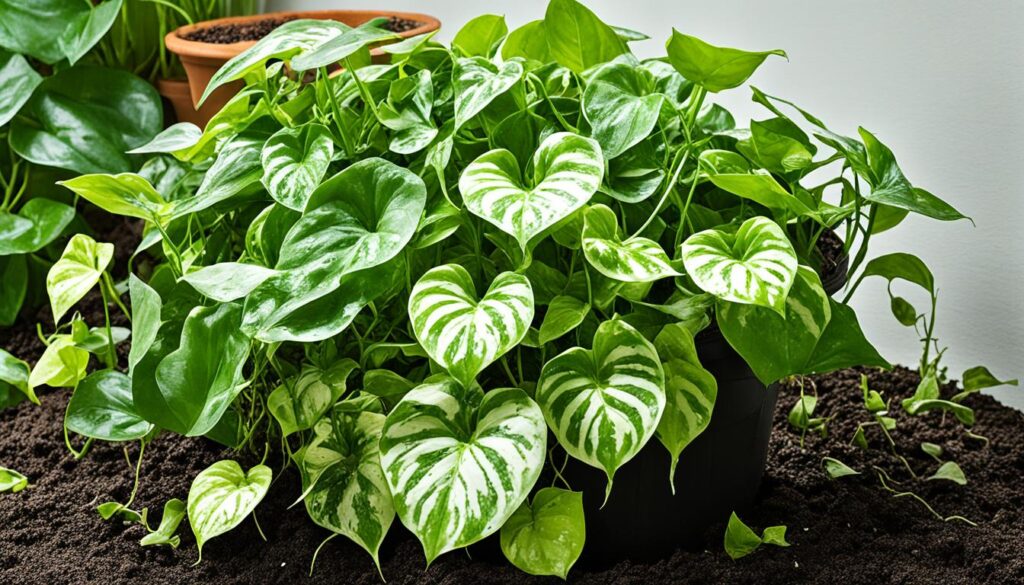
“Proper fertilization is key for your pothos’s health and growth. But, don’t overdo it. Watching for signs can help you fix pothos fertilizer issues early.”
Pothos Fertilizer: Boost Your Plant’s Growth
Fertilizing your pothos plant can greatly improve its growth and look. The benefits of pothos fertilizer include vibrant foliage, vigorous growth, and even blooming. By knowing what nutrients pothos needs and choosing the right fertilizer, your plant will get the best nutrients to thrive.
Regular, moderate fertilizing during the growing season helps your pothos reach its best. This makes your plant lush and healthy, turning your space into a beautiful green oasis. The importance of pothos fertilization is huge, as it adds essential nutrients to the soil and keeps the plant healthy.
Proper fertilizing leads to amazing pothos growth with fertilizer. The right fertilizer gives the nutrients your plant needs to grow. This means more leaves, stronger stems, and maybe even flowers. This makes your pothos look better and clean the air, making your space look great.
“Fertilizing your pothos is a simple yet impactful way to keep your plant thriving and vibrant. With the right approach, you can unlock the full potential of your green companion.”
Knowing the benefits of pothos fertilizer and fertilizing regularly ensures your pothos gets what it needs. Choose the right fertilizer and care for your pothos well. You’ll get a lush, healthy, and beautiful plant that adds to your space.
Environmental Factors Affecting Pothos Growth
Fertilizer is key for pothos plants’ growth and health. But, other environmental factors matter too. Light, temperature, humidity, and watering can change how well pothos plants grow and what nutrients they need. Make sure your pothos gets the right light, stays at a comfy temperature, and is watered right. This will make your fertilizing efforts work better and help your plant grow well.
Lighting Requirements for Pothos
Pothos love bright, indirect light. They need enough light to stay healthy and full. Direct sunlight can burn their leaves, causing them to turn color and get damaged. So, place your pothos where it gets lots of filtered light all day to keep it looking great.
Temperature and Humidity Considerations
Temperature and humidity also affect pothos plants. They do best in temperatures between 70°F and 90°F and like higher humidity. If your pothos is too hot or cold, or if the air is too dry, it can get stressed, grow slowly, or have other problems.
Watering Habits and Soil Moisture
How you water your pothos matters a lot. They like their soil to be consistently moist, but not soaked. Too much or too little water can cause issues like root rot or wilting. Check the soil often and water when it needs it to keep your pothos happy.
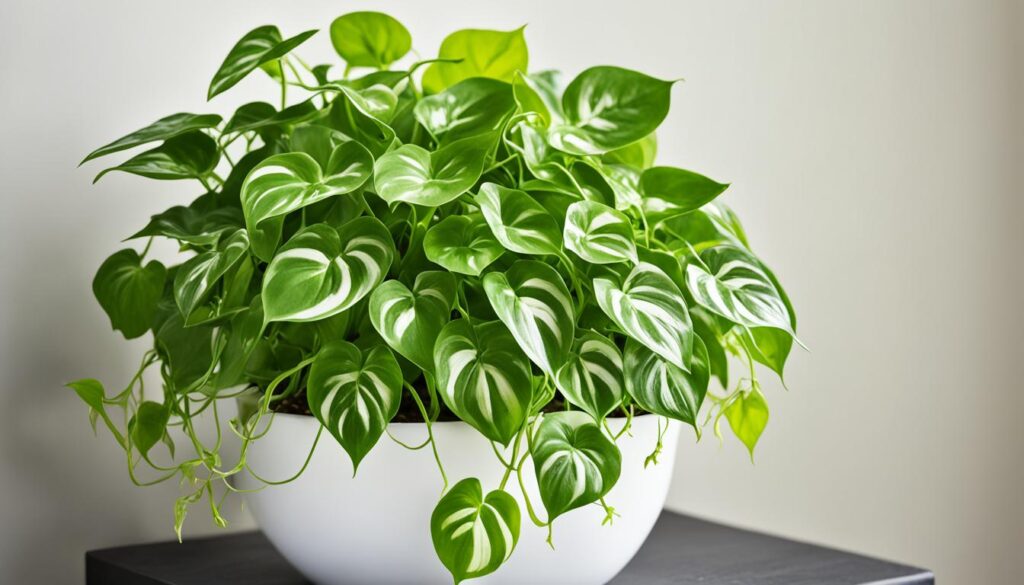
Understanding these environmental factors helps you create the best conditions for your pothos. A good balance of light, temperature, humidity, and watering will help your pothos grow well and stay healthy. This way, your pothos will be a beautiful part of your indoor space.
Pothos Propagation and Fertilization
Feeding your mature pothos plants is important. But, don’t forget about the fertilization needs of propagated pothos cuttings. When propagating pothos, new cuttings need a balanced fertilizer. This helps with their growth and development.
Using a diluted liquid fertilizer or a bit of slow-release granular fertilizer is good. It encourages strong root growth and new leaves.
It’s key to know the nutrient needs of your pothos propagations. Giving them the right fertilization helps them grow well. With the right pothos fertilizer, you can boost their growth and help them establish a strong base.
Encouraging New Growth
Here are some tips to promote your pothos propagations:
- Use a balanced liquid fertilizer at half-strength, every two to three weeks.
- Or, add a bit of slow-release granular fertilizer to the soil when you plant your pothos cuttings.
- Watch the new growth and adjust the fertilizer as needed for optimal nutrition.
- Avoid over-fertilizing to prevent plant stress and damage.
By giving them the right nutrients with pothos fertilizer, you can encourage vigorous propagation and new growth in your pothos plants.
“Proper fertilization is key to nurturing healthy, thriving pothos propagations.”
Conclusion
Fertilizing your pothos plants right can really boost their growth and health. By learning about pothos fertilization, you can give your plants the nutrients they need. This ensures they stay healthy and thrive.
Pothos plants need certain nutrients to stay lush and vibrant. The right fertilizer with balanced NPK can help. Following a regular fertilizing schedule, adjusting as needed, helps your pothos plants grow well.
But, be careful not to over-fertilize. Too much can cause salt buildup, root damage, and leaf discoloration. Watch for signs of nutrient issues or over-fertilization. This way, you can keep your pothos plants healthy and beautiful for years.
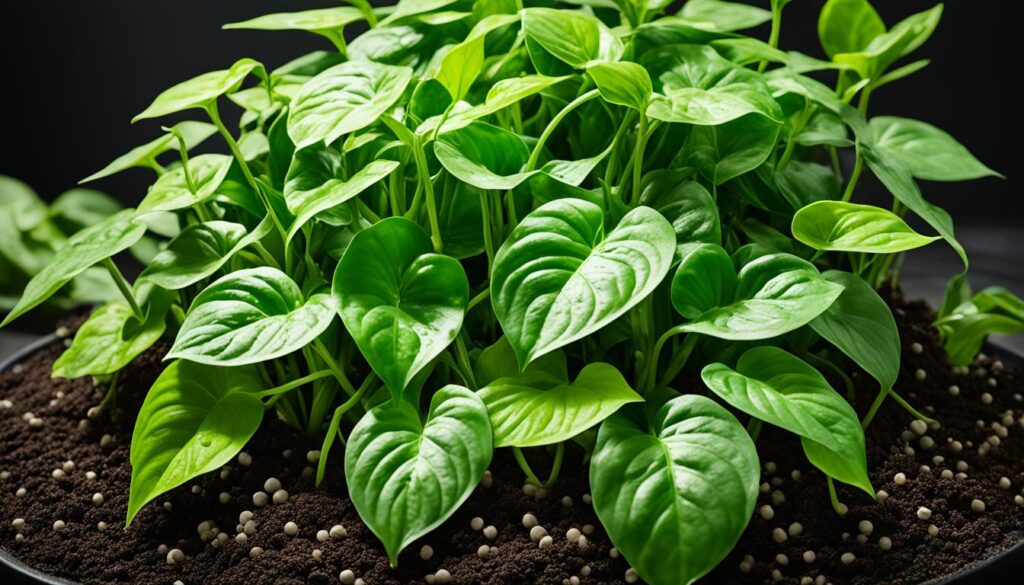


Pingback: What is the best fertilizer for pothos?